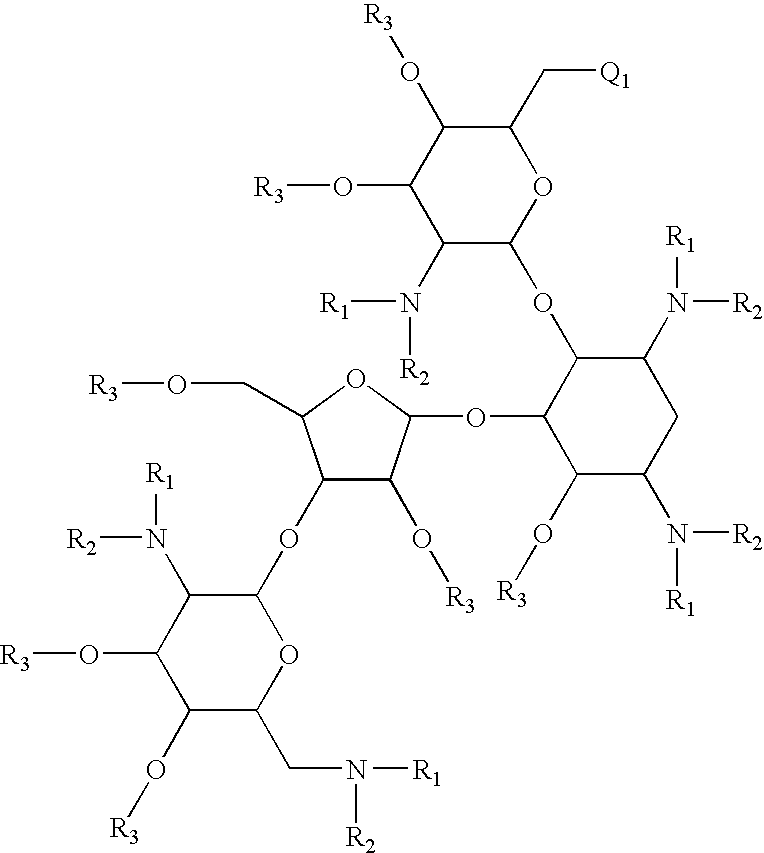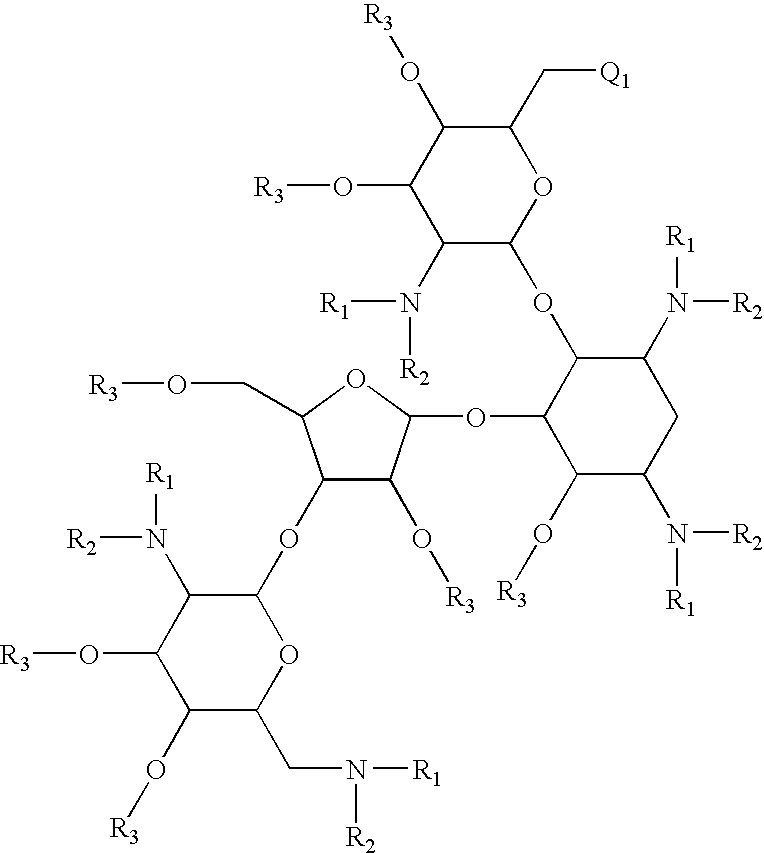Antibacterial 6'-modified 4,5-substituted aminoglycoside analogs
- Summary
- Abstract
- Description
- Claims
- Application Information
AI Technical Summary
Problems solved by technology
Method used
Image
Examples
example 1
Preparation of N-Protected Paromomycin
[0071]
[0072]The exocyclic amino groups of Paromomycin were converted into the corresponding azido groups according to the procedure of Wong (Greenberg, W. A.; Priestley, E. S.; Sears, P. S.; Alper, P. B.; Rosenbohm, C. et al. Design and Synthesis of New Aminoglycoside Antibiotics Containing Neamine as an Optimal Core Structure: Correlation of Antibiotic Activity with in Vitro Inhibition of Translation. J. Am. Chem. Soc. 1999, 121, 6527-6541) using paromomycin instead of neomycin.
[0073]1H NMR (300 MHz, DMSO) δ 1.36 (q, J=12 Hz, 1H), δ 1.99-2.06 (m, 1H) δ 3.37-3.73 (m, 1H) δ 2.97-3.02 (m, 1H), δ 3.19-3.27 (m, 1H), δ 3.37-3.73 (m, 15H), δ 3.88-3.95 (m, 2H), δ 4.16-4.25 (m, 2H), δ 4.44 (t, J=5.7 Hz, 1H) δ 4.75 (t, J=4.8 Hz, 1H), δ 4.93 (d, J=5.2 Hz, 1H), δ 5.03 (d, J=1.6 Hz, 1H), δ 5.15 (d, J=5.1 Hz, 1H) δ 5.22 (d, J=4.6 Hz, 1H), δ 5.28 (s, 1H), δ 5.39 (d, J=5.7 Hz, 1H), δ 5.59 (t, J=4.8 Hz, 2H), δ 5.67 (d, J=3.7 Hz, 1H); 13C NMR δ 106.97, 97.64, 95...
example 2
Selective protection of the 6′-position with Tips
[0074]
[0075]To an oven dried 50.0 mL bottom flask equipped with magnetic stirrer was added per-azidoparomomycin from the above reaction (2.63 g, 3.5 mmol), 4-DMAP (1.25 g, 10.2 mmol) and anhydrous DMF (28.0 mL). The resulting clear solution was cooled to 0 C in ice-bath while stirring under nitrogen. Triisopropylsilylchloride (0.89 ml, 42.3 mmol) was added dropwise to the stirred reaction mixture via syringe. The reaction was continued stirred for two hours maintaining the temperature at 0° C. The reaction mixture was then partitioned between ethyl acetate and 10% aqueous NaHCO3 solution. The organic layer was separated and washed with saturated brine solution and dried over Na2SO4, filtered and evaporated to dryness to afforded clear oil. The product was obtained after purification by flash chromatography (1.57 g, 50% yield) using gradients of CHCl3 / MeOH (97:3).
[0076]1H NMR (300 MHz, DMSO) δ 1.36 (q, J=12 Hz, 1H), δ 1.90-1.22 (m, 21H...
example 3
Benzyl Protection of Hydroxyl Groups
[0077]
[0078]To a 50.0 mL bottom flask equipped with magnetic stirrer was added the tips protected compound from the previous example (3.77 g, 4.18 mmol) dissolved in anhydrous DMF (20.0 mL). The resulting clear solution was cooled to 0° C. in ice-bath while stirring under nitrogen. 60% NaH (2.34 g, 58.5 mmol) was then added slowly and stirred for 20 minutes. BnBr (4.97 mL, 41.87 mmol) was added dropwise to the stirred reaction mixture via syringe. Temperature of 0° C. was maintained for 1 h followed by 3 h at room temperature. The reaction was then cooled at 0° C. and quenched with saturated NaHCO3 solution (2.0 mL) dropwise. The reaction mixture was then partitioned between DCM and 10% aqueous NaHCO3 solution. The organic layer was separated and washed with saturated brine solution and dried over Na2SO4, filter and evaporated to dryness to afforded clear oil which was purified by silica gel chromatography using gradients of Hexane / EtOA (9:1) to a...
PUM
| Property | Measurement | Unit |
|---|---|---|
| Antimicrobial properties | aaaaa | aaaaa |
| Configuration | aaaaa | aaaaa |
Abstract
Description
Claims
Application Information
 Login to View More
Login to View More - R&D
- Intellectual Property
- Life Sciences
- Materials
- Tech Scout
- Unparalleled Data Quality
- Higher Quality Content
- 60% Fewer Hallucinations
Browse by: Latest US Patents, China's latest patents, Technical Efficacy Thesaurus, Application Domain, Technology Topic, Popular Technical Reports.
© 2025 PatSnap. All rights reserved.Legal|Privacy policy|Modern Slavery Act Transparency Statement|Sitemap|About US| Contact US: help@patsnap.com



